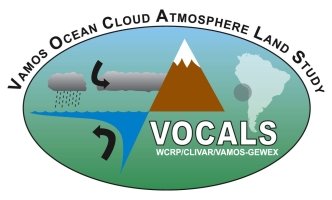PreVOCA: VOCALS Model Assessment Fall 2007 |
 |
VOCALS Homepage | VOCALS at the University of Washington | Rob Wood's homepage
Mailing List
Links
Model Data Formats An example NetCDF file containing the essential structure is available here An IDL program to write NetCDF files with the basic structure is available here MODEL OUTPUT RESOLUTION: To enable convenient comparison of models and observations, all models are requested to interpolate outputs to the same horizontal grid and resolution. Since our emphasis is on regional and larger scales, use a 1x1 degree grid, centered on lat gridpoints ranging from -40 to 0 degrees (40-0 S) and lon ranging from -110 to -60 degrees (110-60 W). All output should be at 3 hour time resolution, either averaged over 00-03 UTC, 03-06 UTC, etc., or instantaneous at 0130, 0430, etc. This allows good comparison with GEOS and MODIS/A-Train data. Output field dimensions should be lon by lat by height (if applicable) by time, giving a 41 x 41 x nz x 248 dimensional dataset. Use your native model vertical grid. REQUESTED MODEL OUTPUT: Each model should submit a brief MS Word or plain text documentation file and a netcdf output file. The 1D outputs document your output grid, the 2Dxtime outputs will be used for most of the satellite comparison and comparison with the WHOI stratus buoy at 20S, 85W. The 3D outputs will be used for constructing mean cross sections along 20 W, examining the correlation of leading modes of wind variability with the PBL structure, and looking at aerosol distributions above the boundary-layer top. Documentation File The documentation file should include: Model Output File The output file, in netcdf format, should include 1D fields: For the remaining three fields, we assume the layers are numbered from the top, so k = 1 is the top level. We let LWPica(k) be the integrated grid-box liquid water path including and above layer k. Use only liquid to exclude ice cloud. Define a cloud weighting function cwf(k) = lcf*ncwf(k), k = 1,…nz, where ncwf(k) = exp(-K*LWPica(k-1)) – exp(-K*LWPica(k)) and LWPica(k) is the integrated grid-box liquid water path above and including layer k. Here K = 156/lcf in units of m^2/kg. We let the surface cloud weighting function cwf(nz+1) = 1 – (cwf(1)…+cwf(nz)). Please email robwood@atmos.washington.edu for clarification or further details |